- Landforms
Landforms formed from Sediment Deposition
This constructive factor of landforms involves the transportation of loose materials such as rocks, sand particles, or organic matter (all known as sediments), by agents such as water, wind, and glacier over long distances, and depositing them somewhere else when the agents lose their transporting power. This process takes place after a destructive process such as erosion or weathering has taken place. It is easy to tell if a landform is created by erosion or sedimentation by looking at the deep cuts or gullies in it, or by the fine arrangement of the layers in it.
Sediment is the term for a solid material that is or has been transported from its site of origin by air, water, gravity, or ice to a field or low landscape position.
When sediments are in transport, they can cut and polish themselves (abrasion) and other exposed rock surfaces, leaving the sediments smooth and finely shaped.
Deposition occurs when the amount of sediment becomes greater than the carrying capacity of the force that is moving it. A deposition is the laying down (settling) of eroded material, and they usually occur along the coasts, in the seas, and low lying grounds. These areas are called depositional environments.

The illustration above shows how sedimentary deposition can result in the formation of an eyot and oxbow lake. From A to D, you will notice that the slow-moving river has lost its power to transport sediments and therefore it deposits them as it meanders (moves in curves). With time, erosion and deposition can cause part of the water to cut off and form an oxbow lake.
When these sediments are deposited at one place over a long time, they solidify in layers (strata) and become landforms. Some great examples of landforms created by sediment deposition include sand-dunes, deltas, caves, and sedimentary rock shelves.
Our research for this topic included these sources:
1. Volcanic Landforms, Volcanoes and Plate Tectonics, Prof. Stephen A. Nelson
www.tulane.edu/~sanelson/Natural_Disasters/volclandforms.htm
2. Dunn, Margery G. (Editor). (1989, 1993). “Exploring Your World: The Adventure of Geography.” Washington, D.C.: National Geographic Society. www.nationalgeographic.org/encyclopedia/plateau/
